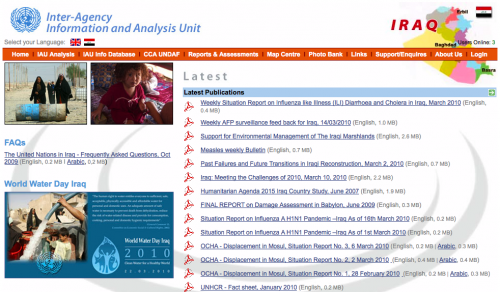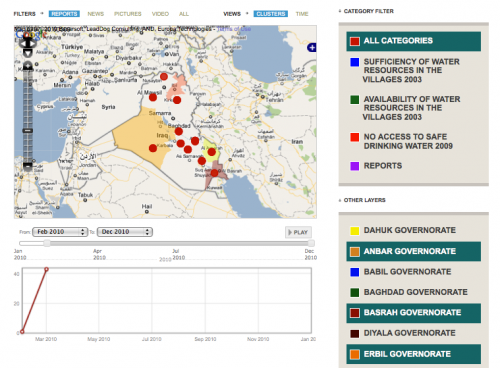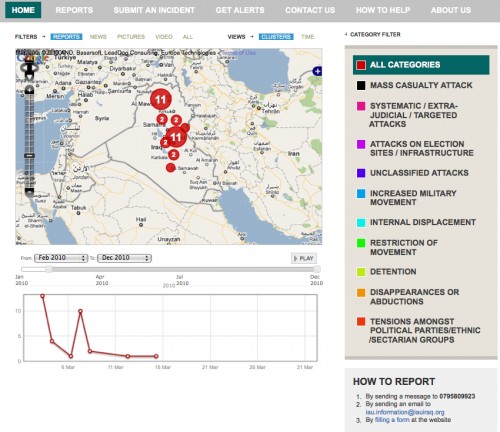Anahi Ayala Iacucci is a second-year graduate student at the School of International and Public Affairs (SIPA) and the Director of Ushahidi-Chile @SIPA. Anahi recently returned from Amman, Jordan, where she worked with a team of graduate SIPA students advising a UN agency on the use of the Ushahidi platform in Iraq.
When we first started our project for the Iraq Inter-Agency Information and Analysis Unit (IAU) based in Amman, our task was to improve their website, and specifically to work on a section profiling the different governorates in Iraq. The problem to solve was a common one in the U.N. system: the unit had too much information coming from different U.N. agencies on a range of topics, and needed to aggregate it in a coherent and easily comprehensible way.
The IAU had another problem that many U.N. agencies also face: a disconnect between the agency and the Iraqi people. The IAU wanted to extend its reach beyond the U.N. agencies and the NGOs already using its website, and establish a connection with the Iraqi academic world, the Iraqi Diaspora, and communities in Iraq. Improving communication with Iraqis is even more necessary if we consider that the U.N. workers have little mobility inside the country, and that the majority of the agencies and organizations are based in Amman.
 Our team first visited Amman in January, to present a range of new media tools that could enhance the IAU Web site and/or improve communication between humanitarian organizations and with the Iraqi people. The agencies we spoke with, including the Office for the Coordination of Humanitarian Affairs (OCHA), the United Nations Development Programme, the United Nations Assistance Mission for Iraq, IAU and the World Food Programme, expressed an interest in learning more about Ushahidi. Our task was quickly refocused to be a deep study of Ushahidi and its possible applications to development and long-term issues in Iraq.
Since then, there has been three months of long discussions within the team, e-mails to Ushahidi's Patrick Meier, e-mails to the Ushahidi-Haiti Project Team @ Tufts (hundreds of thanks to Hilde, Carol, Trevor and Roz, who baby-sat us for an entire day in the Sit Room in Boston), discussions with U.N. professionals, OCHA and U.N. field monitors and research on all the other Ushahidi platforms built since Kenya.
Our team first visited Amman in January, to present a range of new media tools that could enhance the IAU Web site and/or improve communication between humanitarian organizations and with the Iraqi people. The agencies we spoke with, including the Office for the Coordination of Humanitarian Affairs (OCHA), the United Nations Development Programme, the United Nations Assistance Mission for Iraq, IAU and the World Food Programme, expressed an interest in learning more about Ushahidi. Our task was quickly refocused to be a deep study of Ushahidi and its possible applications to development and long-term issues in Iraq.
Since then, there has been three months of long discussions within the team, e-mails to Ushahidi's Patrick Meier, e-mails to the Ushahidi-Haiti Project Team @ Tufts (hundreds of thanks to Hilde, Carol, Trevor and Roz, who baby-sat us for an entire day in the Sit Room in Boston), discussions with U.N. professionals, OCHA and U.N. field monitors and research on all the other Ushahidi platforms built since Kenya.
 The issue we were struggling with was unique. The value of a platform like Ushahidi in an emergency situation is made obvious by looking at the Haiti, Chile, and Kenya deployments. But what about when there is not an immediate crisis? How does the information presented change if someone for example wants to monitor the water situation in a country? Is there a difference in quality, quantity and geo-location of data when passing from an emergency setting to a long-term development situation?
The issues emerging from our study have been incredibly interesting. Not only are emergency and development information extremely different, there is also a huge change in the way data is presented on a map. In the example of the water issue in Iraq, for example, all the data is expressed as a percentage. In addition to that most of the data is geo-located within a region or area, not at a specific point. Also, the water data need to be located on a specific time frame that need to be analyzed in a separate way from the existing and future data populating the map.
Even in looking at all those differences, we realized that the Ushahidi platform had great potential in the field of development, i.e. in terms of helping to analyze the data itself: the possibility to see different categories marked with different colors at the same time for example, could help the viewer see the connection between the availability of water resources and the mortality rate, or the ratio of amount of water taken from wells to number of diarrhea cases, in a very immediate and visual way.
At the end of our second trip in March, we had a list of 20 new features and improvements to propose to the Ushahidi team that would help the platform work as a development tool. We had also built and tested two different Ushahidi platforms for the IAU/OCHA: one on water issues, and another one on monitoring Protection of Civilians incidents. By the end of April, we will provide the IAU/OCHA office in Amman with two comprehensive guides: one on the general use of Ushahidi, and the features needed to customize the platform for development indicators, and another practical training guide for the use of the platform by U.N. personnel in an emergency/crisis context.
The issue we were struggling with was unique. The value of a platform like Ushahidi in an emergency situation is made obvious by looking at the Haiti, Chile, and Kenya deployments. But what about when there is not an immediate crisis? How does the information presented change if someone for example wants to monitor the water situation in a country? Is there a difference in quality, quantity and geo-location of data when passing from an emergency setting to a long-term development situation?
The issues emerging from our study have been incredibly interesting. Not only are emergency and development information extremely different, there is also a huge change in the way data is presented on a map. In the example of the water issue in Iraq, for example, all the data is expressed as a percentage. In addition to that most of the data is geo-located within a region or area, not at a specific point. Also, the water data need to be located on a specific time frame that need to be analyzed in a separate way from the existing and future data populating the map.
Even in looking at all those differences, we realized that the Ushahidi platform had great potential in the field of development, i.e. in terms of helping to analyze the data itself: the possibility to see different categories marked with different colors at the same time for example, could help the viewer see the connection between the availability of water resources and the mortality rate, or the ratio of amount of water taken from wells to number of diarrhea cases, in a very immediate and visual way.
At the end of our second trip in March, we had a list of 20 new features and improvements to propose to the Ushahidi team that would help the platform work as a development tool. We had also built and tested two different Ushahidi platforms for the IAU/OCHA: one on water issues, and another one on monitoring Protection of Civilians incidents. By the end of April, we will provide the IAU/OCHA office in Amman with two comprehensive guides: one on the general use of Ushahidi, and the features needed to customize the platform for development indicators, and another practical training guide for the use of the platform by U.N. personnel in an emergency/crisis context.
 Lack of access to potable water is the number one long-term issue of concern for development practitioners in Iraq, and, with the necessary modifications Ushahidi could help the various U.N. agencies and NGOs coordinate their efforts to ensure that people in the large and complex country have access to safe drinking water.
But as the recent bombings and upsurge in violence in the aftermath of Iraq’s March parliamentary elections illustrated, the country is still very much at risk for violent crisis. Coordination in the aftermath of incidents that put people’s lives at risk is still a very important need that Ushahidi can definitely help fill for agencies operating in Iraq. Now it is only up to them to use it.
Lack of access to potable water is the number one long-term issue of concern for development practitioners in Iraq, and, with the necessary modifications Ushahidi could help the various U.N. agencies and NGOs coordinate their efforts to ensure that people in the large and complex country have access to safe drinking water.
But as the recent bombings and upsurge in violence in the aftermath of Iraq’s March parliamentary elections illustrated, the country is still very much at risk for violent crisis. Coordination in the aftermath of incidents that put people’s lives at risk is still a very important need that Ushahidi can definitely help fill for agencies operating in Iraq. Now it is only up to them to use it.
 Our team first visited Amman in January, to present a range of new media tools that could enhance the IAU Web site and/or improve communication between humanitarian organizations and with the Iraqi people. The agencies we spoke with, including the Office for the Coordination of Humanitarian Affairs (OCHA), the United Nations Development Programme, the United Nations Assistance Mission for Iraq, IAU and the World Food Programme, expressed an interest in learning more about Ushahidi. Our task was quickly refocused to be a deep study of Ushahidi and its possible applications to development and long-term issues in Iraq.
Since then, there has been three months of long discussions within the team, e-mails to Ushahidi's Patrick Meier, e-mails to the Ushahidi-Haiti Project Team @ Tufts (hundreds of thanks to Hilde, Carol, Trevor and Roz, who baby-sat us for an entire day in the Sit Room in Boston), discussions with U.N. professionals, OCHA and U.N. field monitors and research on all the other Ushahidi platforms built since Kenya.
Our team first visited Amman in January, to present a range of new media tools that could enhance the IAU Web site and/or improve communication between humanitarian organizations and with the Iraqi people. The agencies we spoke with, including the Office for the Coordination of Humanitarian Affairs (OCHA), the United Nations Development Programme, the United Nations Assistance Mission for Iraq, IAU and the World Food Programme, expressed an interest in learning more about Ushahidi. Our task was quickly refocused to be a deep study of Ushahidi and its possible applications to development and long-term issues in Iraq.
Since then, there has been three months of long discussions within the team, e-mails to Ushahidi's Patrick Meier, e-mails to the Ushahidi-Haiti Project Team @ Tufts (hundreds of thanks to Hilde, Carol, Trevor and Roz, who baby-sat us for an entire day in the Sit Room in Boston), discussions with U.N. professionals, OCHA and U.N. field monitors and research on all the other Ushahidi platforms built since Kenya.
 The issue we were struggling with was unique. The value of a platform like Ushahidi in an emergency situation is made obvious by looking at the Haiti, Chile, and Kenya deployments. But what about when there is not an immediate crisis? How does the information presented change if someone for example wants to monitor the water situation in a country? Is there a difference in quality, quantity and geo-location of data when passing from an emergency setting to a long-term development situation?
The issues emerging from our study have been incredibly interesting. Not only are emergency and development information extremely different, there is also a huge change in the way data is presented on a map. In the example of the water issue in Iraq, for example, all the data is expressed as a percentage. In addition to that most of the data is geo-located within a region or area, not at a specific point. Also, the water data need to be located on a specific time frame that need to be analyzed in a separate way from the existing and future data populating the map.
Even in looking at all those differences, we realized that the Ushahidi platform had great potential in the field of development, i.e. in terms of helping to analyze the data itself: the possibility to see different categories marked with different colors at the same time for example, could help the viewer see the connection between the availability of water resources and the mortality rate, or the ratio of amount of water taken from wells to number of diarrhea cases, in a very immediate and visual way.
At the end of our second trip in March, we had a list of 20 new features and improvements to propose to the Ushahidi team that would help the platform work as a development tool. We had also built and tested two different Ushahidi platforms for the IAU/OCHA: one on water issues, and another one on monitoring Protection of Civilians incidents. By the end of April, we will provide the IAU/OCHA office in Amman with two comprehensive guides: one on the general use of Ushahidi, and the features needed to customize the platform for development indicators, and another practical training guide for the use of the platform by U.N. personnel in an emergency/crisis context.
The issue we were struggling with was unique. The value of a platform like Ushahidi in an emergency situation is made obvious by looking at the Haiti, Chile, and Kenya deployments. But what about when there is not an immediate crisis? How does the information presented change if someone for example wants to monitor the water situation in a country? Is there a difference in quality, quantity and geo-location of data when passing from an emergency setting to a long-term development situation?
The issues emerging from our study have been incredibly interesting. Not only are emergency and development information extremely different, there is also a huge change in the way data is presented on a map. In the example of the water issue in Iraq, for example, all the data is expressed as a percentage. In addition to that most of the data is geo-located within a region or area, not at a specific point. Also, the water data need to be located on a specific time frame that need to be analyzed in a separate way from the existing and future data populating the map.
Even in looking at all those differences, we realized that the Ushahidi platform had great potential in the field of development, i.e. in terms of helping to analyze the data itself: the possibility to see different categories marked with different colors at the same time for example, could help the viewer see the connection between the availability of water resources and the mortality rate, or the ratio of amount of water taken from wells to number of diarrhea cases, in a very immediate and visual way.
At the end of our second trip in March, we had a list of 20 new features and improvements to propose to the Ushahidi team that would help the platform work as a development tool. We had also built and tested two different Ushahidi platforms for the IAU/OCHA: one on water issues, and another one on monitoring Protection of Civilians incidents. By the end of April, we will provide the IAU/OCHA office in Amman with two comprehensive guides: one on the general use of Ushahidi, and the features needed to customize the platform for development indicators, and another practical training guide for the use of the platform by U.N. personnel in an emergency/crisis context.
 Lack of access to potable water is the number one long-term issue of concern for development practitioners in Iraq, and, with the necessary modifications Ushahidi could help the various U.N. agencies and NGOs coordinate their efforts to ensure that people in the large and complex country have access to safe drinking water.
But as the recent bombings and upsurge in violence in the aftermath of Iraq’s March parliamentary elections illustrated, the country is still very much at risk for violent crisis. Coordination in the aftermath of incidents that put people’s lives at risk is still a very important need that Ushahidi can definitely help fill for agencies operating in Iraq. Now it is only up to them to use it.
Lack of access to potable water is the number one long-term issue of concern for development practitioners in Iraq, and, with the necessary modifications Ushahidi could help the various U.N. agencies and NGOs coordinate their efforts to ensure that people in the large and complex country have access to safe drinking water.
But as the recent bombings and upsurge in violence in the aftermath of Iraq’s March parliamentary elections illustrated, the country is still very much at risk for violent crisis. Coordination in the aftermath of incidents that put people’s lives at risk is still a very important need that Ushahidi can definitely help fill for agencies operating in Iraq. Now it is only up to them to use it.